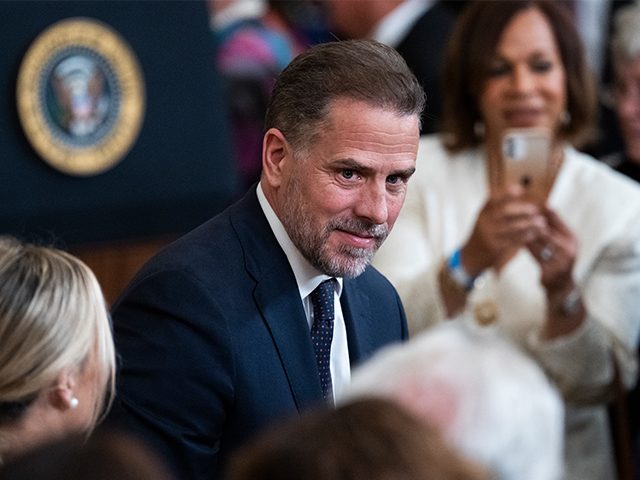Hunter Biden debuted three new paintings in New York City to mixed reviews on Thursday.
About 50 people attended Hunter’s “Bridging the Abstract” exhibit at his art dealer’s Soho gallery, including art appreciators and critics. Those in attendance viewed the pricey paintings on sale for $85,000 each. The price of Hunter’s artwork has ranged between $75,000 to $500,000 throughout his short career.
One attendee who was permitted to view the art told the New York Post that Hunter’s newest works were “terrible.” “I think it’s terrible — the two on the right as you walk in,” said the man who refused to give his name.
Hunter’s newest works of art contrast his prior shapes and forms. Previously painting bright and flowing contours with shiny finishes, the style of Hunter’s recent art appears flat and motionless with geometric shapes that seem misplaced throughout the large canvases.
The stylistic departure raises questions of whether the novice artist is able to develop a recognizable form that will attract collectors.
A Georgetown-based collector, who asked to remain anonymous for fear of retribution, told Breitbart News in a statement that Hunter’s art is “close” to the style he appreciates but appears to be “from someone trying to find their style.”
“In the contemporary art world, a perplexing pattern has emerged: artists weaving high-priced yet ostensibly uninspired works,” he said. “An enigmatic figure, Hunter Biden, personifies this conundrum, crafting monotonous pieces that prioritize marketability over the brilliant spectrum of originality,” he added.
Hunter’s art dealer, Georges Bergès, who was previously charged with assault with a deadly weapon and “terrorist threats,” according to public records from the Santa Cruz Police Department, defended Hunter’s art.
“A lot of people are interested in his artwork,” he told the Post. “The very serious people in the art world are taking note of his work.”
In total, Hunter has anonymously sold about 12 paintings for less than $500,000, the Washington Post reported in January. It is unclear how much money Hunter’s art has generated, but estimates suggest he has earned at least five times more than the average American artist — all while being a novice painter.
The art industry is known for shady business transactions. A Senate subcommittee report detailed in 2020 how the art market serves as a vehicle for money laundering:
The art industry is considered the largest, legal unregulated industry in the United States. Unlike financial institutions, the art industry is not subject to Bank Secrecy Act’s (“BSA”) requirements, which mandate detailed procedures to prevent money laundering and to verify a customer’s identity. While the BSA does not apply to art transactions by art dealers and auction houses, sanctions do. No U.S. person or entity is allowed to do business with a sanctioned individual or entity.
House Oversight Committee Chair James Comer (R-KY) is investigating Hunter’s anonymous art sales. He told Breitbart News in November he is 95 percent sure Hunter’s sold artwork has found its way to China, potentially compromising the president.
“We are 95% sure that that artwork went to China,” Comer said. “We don’t know where exactly that went to in China, but we’re going to try to find out when we get subpoena power.”
Meanwhile, the White House has defended Hunter’s art business as transparent. The president’s 53-year-old son has also remained defiant toward his critics, responding “f*ck’em” when asked how he would respond to them.
Follow Wendell Husebø on Twitter @WendellHusebø. He is the author of Politics of Slave Morality.



COMMENTS
Please let us know if you're having issues with commenting.